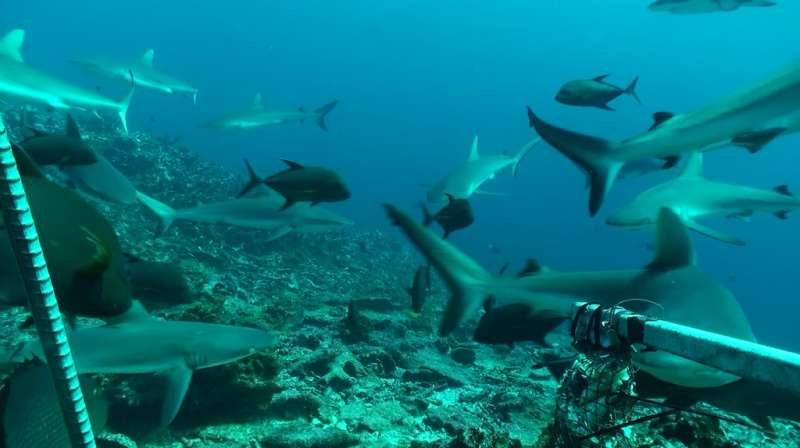Shark census reaches first 100 reefs: Early findings of global survey show existing data may be inaccurate

Researchers attempting the world's largest-ever survey of shark populations have reached their first 100 reefs, collecting exciting footage along the way.
Deploying baited remote underwater video (BRUV) equipment, researchers are catching the ocean's top predators, including sharks and rays, on camera in their natural habitats. Nearly a quarter of these predators are threatened with extinction, yet the lack of comprehensive and up-to-date data on species abundance and distribution is hindering efforts to protect these important marine animals. The survey project, dubbed Global FinPrint, is focusing on coral reef habitats worldwide.
In the first year, the researchers have experienced a few surprises. In some regions of the world, they are seeing more sharks and rays than ever expected, leading the researchers to start a friendly competition on Twitter—#BRUVbattle—for the most sharks in a single screengrab. The current record holder is the team from Australia with 12 gray reef sharks caught on camera along Jarvis Reef in the Pacific Ocean.
"Our international team has deployed more than 5,000 BRUVs and collected more than 5,000 hours of footage," said FinPrint lead scientist Demian Chapman, an associate professor of marine sciences at FIU. He says at least 30 species of sharks and rays have been observed so far.
While some of the early findings are promising, others are concerning.
"In some locations, such as The Bahamas and Australia's Great Barrier Reef, sharks and rays are extremely common. These are places where local shark conservation measures seem to be working, or are areas largely untouched by shark fisheries," Chapman said.
In other, more heavily fished locations, cameras rolled for hours with little to no signs of sharks. For one location off the coast of Malaysia, the researchers collected more than 100 videos. Their efforts resulted in a single shark sighting. In Jamaica a similar number of videos yielded no sharks at all.
The researchers hope to reach more than 200 reefs by the end of 2017 and include about 400 reefs in the final analysis at the end of the three-year project. The research already shows that existing data on shark and ray abundance in some parts of the world is inaccurate.
"The early results are really impressive," said FIU Marine Biologist and FinPrint researcher Mike Heithaus, who also serves as the dean of FIU's College of Arts, Sciences & Education. "With a global network of collaborators, we are going to be able to help prioritize areas for conservation and learn how sharks and rays function in coral reef ecosystems. This information will help ensure we are able to effectively manage these amazing animals and their hugely important ecosystems."
The BRUV technology is enabling scientists to collect more accurate information because the same technology can be used everywhere.
"One thing we hope to do with Global FinPrint is to learn what measures are working for shark and ray conservation around the world and try to help spread these approaches to other places where sharks and rays still occur but are not yet formally protected" Chapman said.
While informative, the BRUVs have also captured some exciting moments along the reefs including a hammerhead flipping one camera and a battle between a feisty crab and a hungry octopus for the bait from the BRUV. The crab won.
With support from philanthropist Paul G. Allen, Global FinPrint is one of several initiatives within the Microsoft co-founder's portfolio of ocean health programs. The new data will be consolidated with thousands of hours of existing video data to form a single dataset for analysis, producing the first global standardized survey of sharks and rays in coral reef environments. The data will be made available through an open-access database platform created by Allen's Vulcan Inc. Researchers, policymakers, governments and others will be able use the database to inform conservation priorities and to better understand the ecological importance of sharks as apex predators.
Provided by Florida International University




















